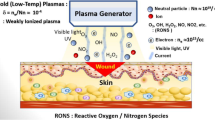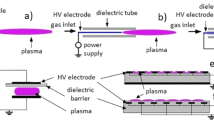Abstract
Low-temperature plasma is a promising method for destroying microorganisms, an alternative to “conventional” methods which have numerous drawbacks. Several plasma-based sterilization technologies are presently under development, but their mechanisms of action are still incompletely understood. Since more than five years, we have investigated the effects of plasma on microorganisms (killing efficacy, and related mechanisms), as well as on the materials being sterilized. This article reports some important observations made during this work, using the commercialized so-called “plasma sterilizers” and “real” low-pressure plasma systems. The mechanism of etching (volatilization) of microorganisms by plasma that we have observed, leads us to believe that plasma may constitute a powerful solution to the clinical problems of deactivating also prions and endotoxins. However, plasma effectiveness is influenced by numerous experimental parameters, which we review here. This inherent complexity, and the weak penetrating power of plasma species, that severely limits plasma effectiveness in the presence of organic residues, packaging material, or complex geometries, are the main limitations of plasma sterilization.
Similar content being viewed by others
REFERENCES
S. Lerouge, Ph.D. thesis, Ecole Polytechnique, Montreal (May 2000).
S. Lerouge, M. Tabrizian, M. R. Wertheimer, R. Marchand, and L'H. Yahia, Biomed. Maters. Eng. Int. J. (2001).
S. Lerouge, C. Guignot, N. Yagoubi, M. Tabrizian, D. Ferrier, and L'H. Yahia, J. Biomed. Mater. Res. 52, 744 (2000).
S. Lerouge, M. R. Wertheimer, R. Marchand, M. Tabrizian, and L'H. Yahia, J. Biomed. Mater. Res. 51, 128 (2000).
S. Lerouge, A. C. Fozza, M. R. Wertheimer, R. Marchand, and L'H. Yahia, Plasms. Polyms. 5, 31 (2000).
P. Jacobs and R. Kowatsch, Endoscopic Surg. Allied Technol. 1, 57 (1993).
R. A. Caputo, Int. J. Processing Sterile Supply, Official Publication of the ESH, No. 4, July/August (1994).
M. G. C. Baldry, J. Appl. Bacteriol. 54, 417 (1983).
M. C. Krebs, P. B´ ecasse, D. Verjat, and J. C. Darbord. Int. J. Pharmaceutics 160, 75 (1998).
R. S. Thomas, J. Cell. Biol. 23, 113 (1964).
D. Warth, Molecular structure of the bacterial spore, in Advances in Microbiology and Physiology, Vol. 17, D. W. Goulds, ed., (1978), p. 1.
K. Kelly-Wintenberg, T. C. Montie, C. Brickman, J. R. Roth, A. K. Carr, K. Sorge, L. C. Wadsworth, and P. P. Y. Tsai, J. Indust. Microbiol. Biotechnol. 20, 69 (1998).
M. Moisan, J. Barbeau, and J. Pelletier, Le Vide (Science, Technique Applications) 299, 15 (2001).
A. C. Fozza, J. E. Klemberg-Sapieha, and M. R. Wertheimer, Plasms. Polyms. 4, 183 (1999).
E. Kay, in Plasma Chemistry III, Topics in Current Chemistry, Vol. 94, Springer Verlag, Berlin (1980), p.6.
B. R. M. G. Boucher, Med. Device and Diagn. Ind. 7, 51 (1985).
F. D. Egitto, V. Vukanovic, and G. N. Taylor, Plasma etching of organic polymers, in Plasma Deposition, Treatments, and Etching of Polymers, d'Agostino R, ed., Academic Press, Boston, (1990), p. 321.
A. M. Wrobel, B. Lamontagne, and M.R. Wertheimer, Plasma Chem. Plasma Process. 8, 315 (1988).
S. R. Cain, F. D. Egitto, and F. Emmi, J. Vac. Sci. Technol. A 5, 1579 (1981).
S. Moreau, M. Moisan, M. Tabrizian, J. Barbeau, J. Pelletier, A. Ricard, and L'H. Yahia, J. Appl. Phys. 88, 1166 (2000).
S. M. Lin, Interaction of bacterial spores with radicals generated by microwave and low-temperature radio-frequency discharges, Ph.D. thesis, University of Texas at Arlington (1986).
S. Hury, D. R. Vidal, F. Desor, J. Pelletier, and T. Lagarde, Letters Appl. Microbiol. 26, 241 (1998).
T. T. Chau, K. C. Kao, G. Blank, and F. Madrid, Biomaterials 17, 1273 (1996).
A. V. Khomich, I. A. Soloshenko, V. V. Tsiolko, and I. L. Mikhno, Proc. 12th Int'l. Conf. Gas Discharges and Their Applications, Greifswald, 2, 740 (1997).188 Lerouge, Wertheimer, and Yahia
A. V. Khomich, I. A. Soloshenko, V. V. Tsiolko, and I. L. Mikhno, Proc. Int. Cont. Plasma Phys., Prague, 2745 (1998).
B. Lamontagne, O. M. K¨ uttel, and M. R. Wertheimer, Can. J. Phys. 69, 202 (1991).
M. R. Wertheimer and L. Martinu, in Microwave Discharges: Fundamentals and Applications, C. M. Ferreira and M. Moisan, eds., NATO ASI series 13: Physics, Plenum Press, New York, 302, 465 (1993).
A. C. Fozza, M. Moison, and M. R. Wertheimer, J. Appl. Phys. 88, 20 (2000).
A. Hallil, O. Zabeida, M. R. Wertheimer, and L. Martinu, J. Vac. Sci. Technol. A 18, 882 (2000).
M. Moisan and M. R. Wertheimer, Surf. Coat. Technol. 59, 1 (1993).
A. D. Russel, in Sterilization Technology: A Practical Guide for Manufacturers and Users of Health Care Products, R. F. Morissey and G. B. Phillips, eds., Van Nostrand Reinhold, New York, 3 (1993).
K. Kelly-Wintenberg, A. Hodge, and T. C. Montie, J. Vac. Sci. Technol. A 17, 1539 (1999).
C. Chang, S. F. Ossof, D. C. Lobe, M. H. Dorman, C. M. Dumais, R. G. Qualls, and J. D. Johnson, Appl. Environ. Microbiol. 49, 1361 (1985).
G. J. Tortora, B. R. Funke, and C. L. Case, Microbiology: An Introduction, Fifth Edition, The Benjamin Cummings Publishing Co., New York (1994).
M. J. Alfa, P. DeGagne, and N. Olson, Infect. Control Hosp. Epidemiol. 18, 641 (1997).
A. H. Dadd, K. E. McCormick, and G. M. Daley, J. Appl. Bacteriol. 55, 39 (1983).
H. Shintani, Biomed. Instrum. Technol.30, 449 (1996).
J. C. Darbord, Biomed. Pharmacother. 53, 34 (1999).
V. M. Steelman, A.O.R.N. J. 69, 946 (1999).
S. T. Cookson, J. J. Nora, J. A. Kithas, M. J. Arduino, W. W. Bond, P. H. Miller, J. Monahan, R.E. Hoffman, T. Curiel, D. Kaufman, B. M. Groves, and W. R. Jarvis, Catheter. Cardiovasc. Diagn. 42, 12 (1997).
N. Munakata, M. Saito, and K. Hieda, Photochem. Photobiol. 54, 761 (1991).
Author information
Authors and Affiliations
Corresponding author
Rights and permissions
About this article
Cite this article
Lerouge, S., Wertheimer, M.R. & Yahia, L. Plasma Sterilization: A Review of Parameters, Mechanisms, and Limitations. Plasmas and Polymers 6, 175–188 (2001). https://doi.org/10.1023/A:1013196629791
Issue Date:
DOI: https://doi.org/10.1023/A:1013196629791




